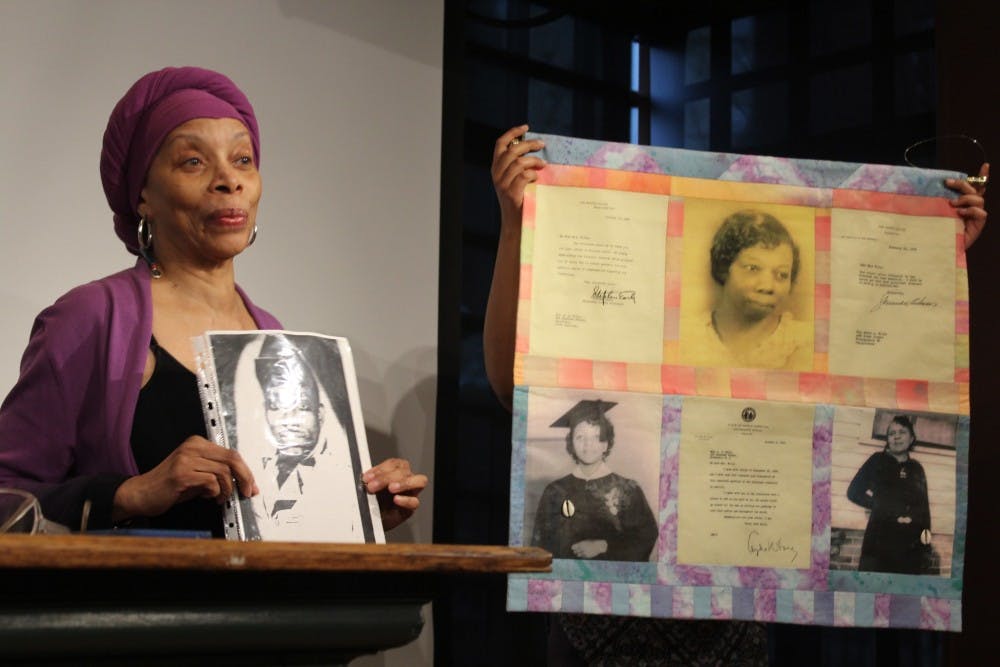The Kelly Writers House bubbles with excited chatter from both students and Philadelphia community members alike. Knitted sweaters lay on display, their interwoven colors bright and beaming against the table top's neutral wood grain. A crowd bustles around, eyes trained on the beautiful fabric.
Tonight's event is Stitched!, where students in Professor Lise Funderburg’s “Ties That Bind” creative nonfiction workshop are presenting their work in conjunction with members of Philadelphia’s textile–based folk and fiber arts community. Professor Funderburg had originally sought funding through the creative writing program, but when grant fell through, the Kelly Writer's House welcomed her in and funded the project. The course seeks to engage undergraduate artists with the fiber and textile artists in the Philadelphia community.
The opening performance places a poem on the projection: “Cul–De–Sac.” The poem addresses time, temporality, and finding beauty in unexpected places. In front of the poem, three women perform a dance. The entire performance is silent, gazes trained on the words and images on screen. The dancers' swift movements draw attention to their woven clothing. Clothed in the same fabric and lost in the same choreography, the dancers project a message of unity.

Courtesy of Kelly Writers House Staff.
Following this performance, a student from Professor Funderberg's class comes on stage clothed in a blue, white, and pink top and presents a creative nonfiction narrative. Her empathy, honesty, and willingness to relay such a personal story to a large audience, to be vulnerable, is dazzling. It starts with a description of her time working in a restaurant, and the instructions given to her on how to treat Indian customers versus non–Indian customers; ice water for the latter, warm water for the former. She then indulges us with descriptions of her family, the warmth shared among them through conversations over dinner and constant laughter, and with people of their common ethnicity, a warmth which contrasts with the animosity directed towards those outside.
Yet, after working with artist Betty Leacraft through the class' mentorship program, the student began to perceive things differently. Among the numerous community artists who were at Stitched!, be it onstage or in the audience—such as Joy O. Ude, a mixed-media artist and designer, and Shelley Donnelly, an interdisciplinary visual artist and educator—Leacraft is a self-proclaimed shape shifter of textiles and mixed media fiber. She also works as a visual artist and an educator. She shares with the audience that her pieces are woven with the artistic and cultural traditions of Africa and the African Diaspora. Additionally, she creates opportunities for underserved communities and individuals by teaching textile art workshops.
Leacraft's biography and accomplishments speak for themselves. As the student stands on stage and reads her piece about their relationship, she looks towards Leacraft, with eyes full of admiration and the deepest respect. Here, Leacraft's guidance has woven an emotional thread between herself and the student. It is apparent such artwork leaves a long lasting impression within the hearts of those it reaches—be it Leacraft's weavings, Donnelly's video installations featuring sewn textiles and garments, or O. Ude's art delving into African American culture as a subset of main stream American culture.

Courtesy of Kelly Writers House Staff.
Leacraft walks on stage to showcase her work, emphasizing the importance of family and ancestry. The work is made of fabric, blue and purple hues coalescing at the bottom, red and orange hues at the top. There are six sections—three pictures and three letters. The pictures are of her grandparents; the letters are conversations between families. The fabric is the emotional connection between them all—through Leacraft's handiwork, she has made them tangible and physical.
The rest of the performance featured students who, throughout the course, had grown closer with the community and closer with their creative selves. They presented numerous pieces, including works on knitting together communities, refugees, video media, and more. Each presentation was a labor of love, with the students' words bringing their experiences back to life and recalling their emotions in vivid detail.
The ties that bind can be found and expressed in many forms. For some, it is through community engagement, for others it is simply meeting people and uncovering similarities. Communal connection has no limits, it can be in words, visual art, dance, and more. But, at the end of the day, we are all bound to something and someone, in some shape or form, and discovering it is simply one of the joys of life.

